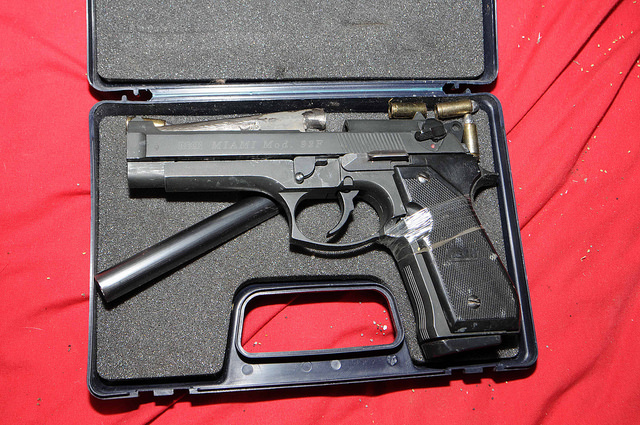How To Transport A Gun Across State Lines

Transporting a firearm across state lines is a task laden with legal intricacies, demanding a nuanced understanding of the governing laws and regulations. Failing to adhere to these protocols can result in severe legal consequences, jeopardizing not only an individual’s freedom but also their ability to responsibly exercise their Second Amendment rights.
In this guide, the reputable firearm community platform Arms Directory explains everything you need to know about interstate gun transportation.
Table of Contents
Federal Laws and Regulations
When it comes to transporting firearms across state lines, understanding the federal landscape is paramount. The Firearm Owners Protection Act (FOPA) serves as a cornerstone in this realm, outlining crucial provisions for responsible gun transport.
FOPA mandates that firearms being transported interstate must be unloaded and secured in a locked container, separate from the ammunition. This emphasizes a commitment to safety and prevents unauthorized access during transit.
However, it’s imperative to note the exceptions and limitations within FOPA. While the act provides a degree of protection, it doesn’t override state laws entirely. Traveling through states with stringent gun control regulations requires meticulous attention to their specific requirements. Some states may necessitate additional measures, such as specific storage conditions or declarations.
State Laws and Regulations
Navigating the diverse landscape of state laws is a crucial aspect of responsible firearm transport across state lines. Each state possesses its unique regulations, necessitating a comprehensive understanding to ensure legal compliance and safe travel.
Some states maintain stringent gun control laws, demanding extra diligence from travelers. For instance, California imposes strict firearm regulations, requiring transportation in a locked container and the avoidance of certain prohibited features. New York mandates that firearms be unloaded and inaccessible during transport.
Researching and comprehending the specific laws of the states through which you plan to travel is paramount. Some states may necessitate notification to law enforcement, while others may impose restrictions on particular types of firearms or accessories. The key is being well-informed and prepared to adhere to each state’s regulations.
Best Practices for Transporting a Gun
Ensuring the safe and legal transport of firearms across state lines demands meticulous planning and adherence to best practices. Responsible gun owners prioritize safety, compliance, and public awareness to contribute to a positive perception of firearm ownership.
1.Properly Securing and Storing Firearms
One of the fundamental pillars of responsible gun transport is ensuring that firearms are securely stored and properly secured during the journey. Utilizing a locked container designed for firearms helps prevent unauthorized access and aligns with legal requirements, especially under the Firearm Owners Protection Act (FOPA). This container should be robust, ensuring that the firearm is inaccessible to anyone without authorized access.
Additionally, consider using trigger locks or cable locks as an added layer of security. This not only fulfills safety requirements but also underscores your commitment to responsible firearm ownership. Remember to place ammunition in a separate container to further comply with regulations and enhance safety measures.
2.Avoiding Attention and Alarm
To maintain a low profile and avoid unnecessary attention while transporting a firearm, adopt a discreet approach. It’s advisable to keep the firearm out of plain sight, even when stored in a locked container. Tinted windows or a dedicated trunk space can contribute to maintaining privacy and preventing any undue concern from passersby.
While lawful firearm transport is your right, it’s essential to recognize that public perception may vary. Minimize the visibility of firearms to avoid causing alarm or concern, promoting a positive image of responsible gun ownership.
3.Choosing the Right Route
Selecting the right route is a strategic consideration when transporting firearms across state lines. Prioritize routes that minimize entry into jurisdictions with stringent gun control laws whenever possible. A direct and straightforward path can help reduce the likelihood of unintentional violations.
Plan your journey ahead of time, considering rest stops and accommodations that align with your commitment to secure firearm transport. Familiarize yourself with state-specific regulations along the chosen route, allowing for smooth navigation through diverse legal landscapes.
4.Documentation and Communication
Carry all necessary documentation, including firearm licenses, permits, and a copy of the FOPA. Being well-prepared to provide information if required by law enforcement helps foster a cooperative and transparent interaction.
In case of any encounters with law enforcement, remain calm, polite, and cooperative. Inform the officers of the presence of a firearm and follow their instructions explicitly. Effective communication can contribute to a smooth interaction, reinforcing the importance of responsible gun ownership.
5.Continuous Education and Awareness
Staying informed about evolving state laws and regulations is an ongoing responsibility for gun owners. Regularly update your knowledge of the legal landscape, ensuring compliance with any changes in regulations. Being an advocate for responsible gun ownership involves continuous education, not only for personal benefit but also to contribute to a positive image of firearm enthusiasts in society.
What To Do If Stopped by Law Enforcement
Encountering law enforcement while transporting a firearm across state lines requires a calm and measured approach to ensure a safe and respectful interaction. Adhering to specific guidelines can contribute to a smooth encounter, fostering positive engagement with law enforcement officers.
Remaining Calm, Polite, and Cooperative
The key to a successful interaction with law enforcement during the transportation of firearms is maintaining composure. Stay calm, be polite, and demonstrate a cooperative attitude. Remember that law enforcement officers are focused on ensuring public safety, and your demeanor plays a crucial role in shaping the nature of the encounter.
Avoid sudden movements and follow instructions carefully. This approach helps alleviate any concerns law enforcement may have and establishes a foundation for open communication.
Informing Law Enforcement and Providing Documentation
Transparency is paramount when interacting with law enforcement while transporting a firearm. Immediately inform the officers of the presence of a firearm in your possession. Clearly state that you are aware of the laws regarding firearm transportation and are committed to complying with all regulations.
Offer to provide the necessary documentation, including your firearm license, permits, and a copy of the Firearm Owners Protection Act (FOPA). Present these documents in a calm and deliberate manner, avoiding any sudden movements that could cause concern.
It’s essential to communicate clearly and concisely, demonstrating your understanding of the situation and commitment to lawful firearm transport. Following these steps not only facilitates a smoother interaction but also promotes a positive perception of responsible gun ownership.
Educating Law Enforcement (Optional)
In some instances, law enforcement officers may not be fully aware of the specific regulations surrounding the transportation of firearms, especially if the encounter occurs in a jurisdiction less accustomed to such scenarios. While it is not a requirement, offering a brief explanation of the relevant laws, such as FOPA, can contribute to mutual understanding.
However, prioritize brevity and clarity, avoiding any confrontational or argumentative tones. The goal is to foster a cooperative environment and ensure that both you and law enforcement officers comprehend the situation accurately.
Conclusion
In conclusion, a comprehensive understanding and adherence to laws governing firearm transportation across state lines are imperative. Prioritize safety, compliance, and responsible gun ownership to ensure smooth travels. Stay informed about evolving laws and regulations, remaining vigilant in upholding the highest standards of firearm transport. By embracing these principles, individuals can contribute to a safer, more responsible gun-owning community while navigating the complexities of interstate firearm transportation with confidence.




